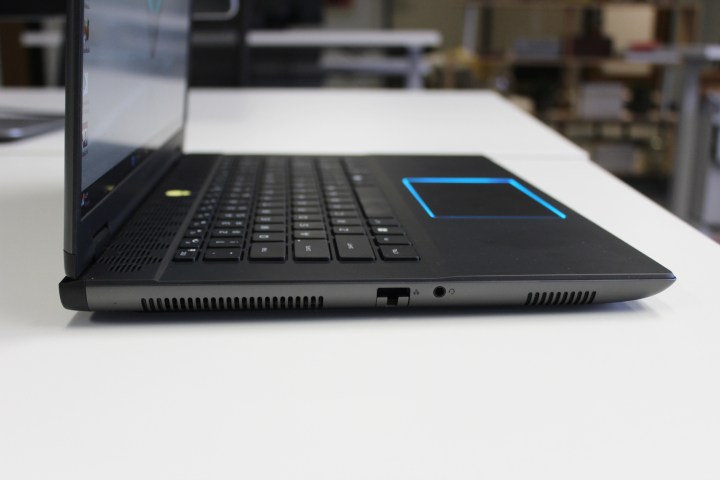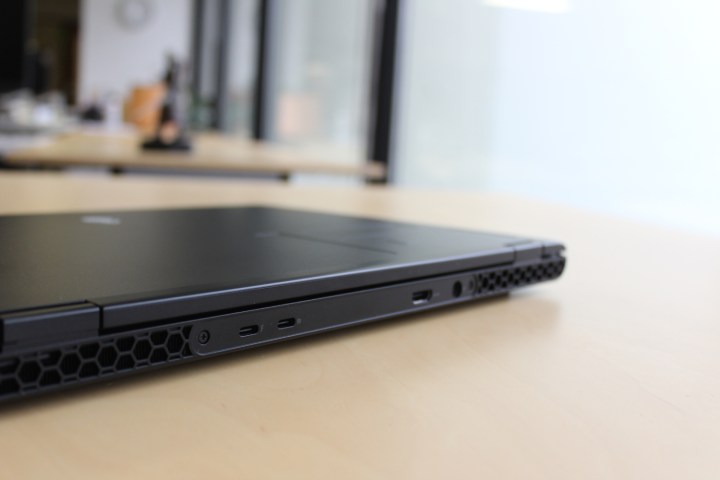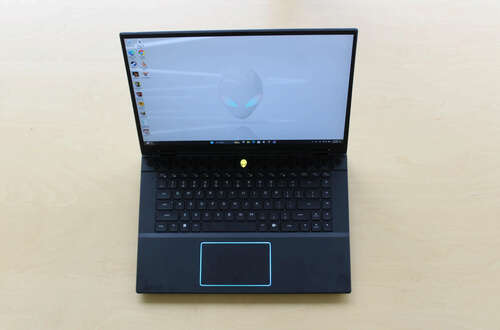
Alienware m16 R2
MSRP $1,650.00
“The Alienware m16 R2 attempts to target a new audience, but just misses the mark in its pricing.”
Pros
- Smaller footprint, streamlined design
- Nice touches of RGB
- Great gaming performance
- Convenient ports
- Upgradeable
Cons
- Limited configurations
- Lackluster screen
- Flimsy touchpad
The Alienware m16 R2 feels like a fresh start for the brand’s gaming laptops. In the era of compact, discreet laptops like the Razer Blade or ROG Zephyrus G14, Alienware laptops haven’t always followed the trend. The m16 laptops, particularly, were the defiantly chunky ones in the lineup.
But with the Alienware m16 R2, many of the hallmarks of the company’s designs have been traded out for something that looks and feels more conventional. The end result is an overall better gaming laptop, even if it ends up failing to compete with the better options out there.
Specs and pricing
| Alienware m16 R2 | |
| Dimensions | 0.93 x 14.33 x 9.81 inches |
| Weight | 5.75 pounds |
| Processor | Intel Core Ultra 7 155H |
| Graphics | RTX 4060 RTX 4070 |
| RAM | 16GB (2x8GB) GDDR6 |
| Display | 16-inch 2560 x 1600 240Hz 3ms |
| Storage | 1TB SSD |
| Touch | No |
| Ports | 1x USB-C 3.2 Gen 2 2x USB-A 3.2 Gen 1 1x USB-C Thunderbolt 4 1x HDMI 2.1 1x RJ45 Ethernet 1x MicroSD card slot 1x 3mm headset jack |
| Wireless | Wi-Fi 6E and Bluetooth 5.1 Optional WWAN |
| Webcam | 1080p at 30 fps |
| Operating system | Windows 11 |
| Battery | 90 watt-hour |
| Price |
$1,449+ |
Alienware currently offers just a single configuration display and processor option. It won’t stay like this forever, as Alienware plans to eventually offer up to a Core Ultra 9, 8TB of storage, and 64GB of RAM. There will even be a cheaper RTX 4050 configuration that starts at $1,449.
But for now, the one configuration on offer for Alienware m16 R2 is as follows: an Intel Core Ultra 7 155H, 16GB of RAM, 1TB of SSD storage, and options for either an RTX 4060 or RTX 4070. It also comes with a 2560 x 1600 240Hz IPS display.
The RTX 4060 configuration starts at $1,650 or $200 more for the RTX 4070. It’s priced just $50 cheaper than the Alienware x16, though we don’t yet have pricing on the 2024 R2 model. Meanwhile, the Dell G16 comes in at $300 cheaper for a nearly identical configuration.
In fact, the Alienware m16 R2 is the first Core Ultra gaming laptop we’ve reviewed, so we’ll have to wait and see how pricing rolls out on other similar gaming laptops.
Design
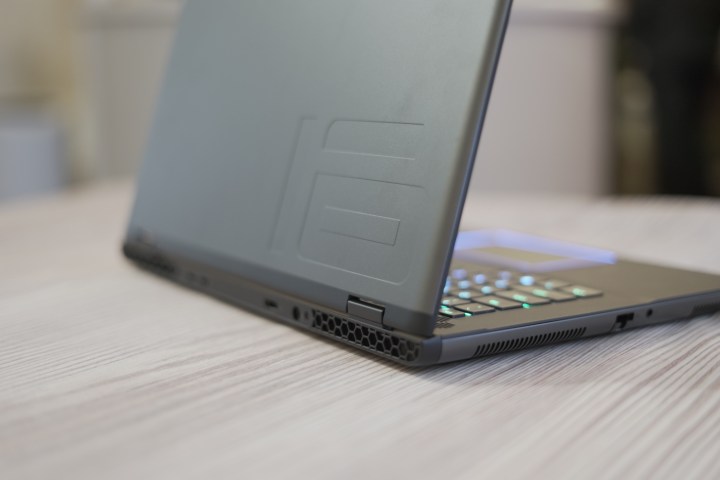
The second generation of the Alienware m16 is a complete redesign of the line, which feels unusual for how new it is. The chassis has been thinned down to 0.94 inches, including trimming 1.42 pounds off the overall weight. It’s a large 16-inch laptop, significantly thicker than something like the Razer Blade 16, Alienware x16, or MacBook Pro 16.
It also has a more conventional hinge, a much smaller bottom bezel under the screen, and a more centered touchpad (now with an outline of RGB). These are all good things, modernizing nearly every aspect of the look and feel.
But the biggest change is the removal of the “thermal shelf,” the large protrusion on the back of the hinge area, which was always sold as extra ventilation and a better position for ports. Lenovo Legion laptops also use a similar thermal shelf, but Alienware was the first to make this a big part of its design ethos. This also means the removal of the Tron-like ring of light — another hallmark of the Alienware brand that’s gone here.
Again, that’s not necessarily a bad thing. In many ways, it’s the stated goal of the m16 R2. It’s meant to be a laptop that blends in, and I think Alienware has pulled it off without compromising too much of its swagger.
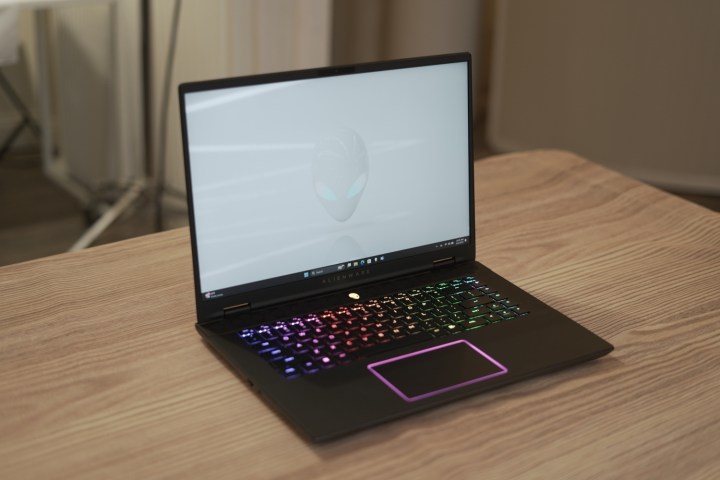
Don’t get me wrong: this design still has plenty of Alienware-isms. The light-up Alienware logo is still there (now centered above the keyboard), as is the honeycomb pattern across the top vents and the “racing stripe” name on the lid. But it feels a bit more like Alienware branding plastered onto a more generic, off-the-shelf midrange gaming laptop. The build quality is decent, but as you use it, you’ll certainly be reminded that it’s not anything too high-end based on the materials used.
The biggest design problem all these changes fixes is the positioning of the keyboard on the original m16 though. In the previous model, it was awkward, to put it lightly. It had a massive footprint on the table, yet it left little room for your palms or a larger touchpad. The m16 R2 resolves all that discomfort and extra size, reducing the overall footprint by 14% and increasing the size of both the touchpad and palm rests.
Keyboard and touchpad
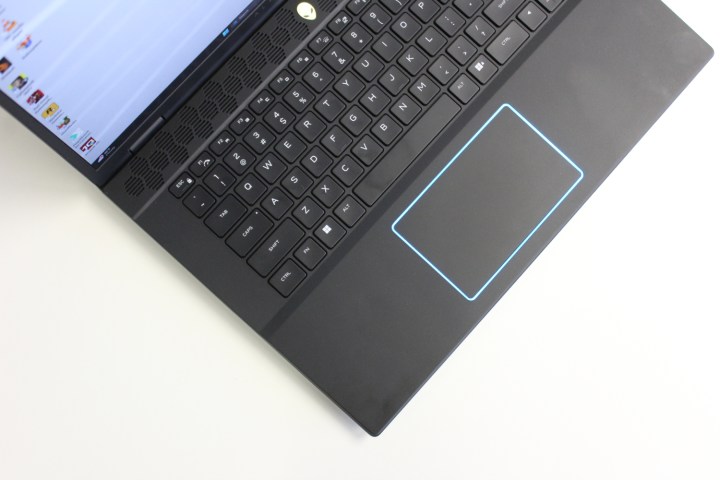
The keyboard is one of the stronger elements of the Alienware m16 R2, and now that the palm rests are larger, it can be enjoyed to its fullest extent. The 1.8mm travel is luxurious, while the keys still feel snappy and accurate for typing. They’re emphasized by per-key RGB backlighting, all controlled through the Alienware Command Center. I like this layout, too, providing some useful function keys on the right and saving the full number pad for the Alienware m18.
Alienware has moved the touchpad closer to the center this time, which looks much less awkward. As mentioned above, it also has a ring of RGB outlining the touchpad, which is more nuanced than the entire surface lighting like on other Alienware models. This feels subtle, which, again, is the name of the game here.
The touchpad itself, unfortunately, isn’t the best. It has a plastic-feeling surface, making for a lackluster tracking experience. It’s usable, but it’s just not going to be as smooth as a glass touchpad, such as the one on the Alienware x16.
Ports
Despite the fact that the thermal shelf is gone, there are still ports located back there. That’s where you’ll find your power, HDMI 2.1, one Thunderbolt 4 port (with 15-watt power delivery), and one USB-C port 3.2. Gen 2 with DisplayPort 1.4. You can power through the Thunderbolt 4 port, but gaming on it is not recommended. I like the position of these ports, making for a convenient location for quick access to power and external display support.
On the sides, you’ll find two USB-A 3.2 Gen 1 ports, an RJ45 Ethernet jack, a microSD card slot, and a 3.5mm headphone jack. Unfortunately, both USB-A ports are on the right side, awkwardly close to where your mouse might be (for right-handed folks). One on each side would have been ideal.
It’s also a bit of a bummer that the full-size SD card slot on the original m16 has been replaced by a microSD card slot. Dell is doing a similar thing with its new XPS machines, and I’m not a fan.
Display
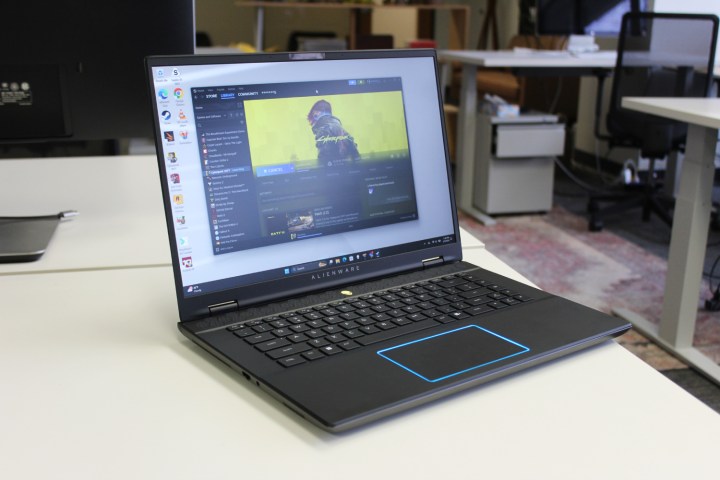
As of now, there is just a single display option available for the Alienware m16 R2. It has a 2560 x 1600 resolution, 240Hz refresh rate IPS panel, and a 3-millisecond response time. The display also comes with Nvidia G-Sync and Advanced Optimus.
Alienware has kept its gaming laptop screens fairly modest, sticking with conventional IPS panels. Many of Alienware’s competitors have opted for OLED or mini-LED, whether it’s Asus, Razer, MSI, or Lenovo. The new ROG Zephyrus G16 even goes for a glossy panel to draw out the clarity of the visuals. But with Alienware, even its most premium entries continue to stick with a standard matte LED. That’s a shame.
Now, I don’t necessarily expect the m16 to have an OLED option since it’s not the most high-end option in Alienware’s lineup. But it’s worth mentioning that options like the 2023 ROG Zephyrus G14 with its mini-LED screen sell for a similar price. Also, the old Alienware m15 used to offer an AMOLED option.
OLED or mini-LED would provide better HDR and improved color accuracy. The Alienware m16 R2’s screen is a bit off, with a Delta-E of 2.19. It’s also a fairly dim screen, with a max brightness of just 289 nits. You’re certainly getting a better IPS screen on the Alienware x16, which is brighter and has better color coverage.
But overall, this is a solid display for gaming. It’s fast and sharp enough; I just wish it were a little brighter and more color-accurate.
Performance
The Alienware m16 R2 is one of the first gaming laptops to come out that use the new Meteor Lake Core Ultra chips from Intel. In particular, this one has the Core Ultra 7 155H. On the surface, this is the same chip you’ll find in less powerful laptops, such as the Asus Zenbook 14 or Dell XPS 14, for that matter. That doesn’t mean you’ll get the same performance, though, since the Alienware m16 R2 can run this chip at 45 watts. As confusing as that might be for an average laptop buyer, that’s hardly Dell’s fault.
The company seems to be saving the 14th-gen Raptor Lake Refresh HX 55-watt chips for the higher-end (and larger) laptops in this lineup. It should be noted, however, that the m16 R1 featured a 55-watt HX chip, with even an alternate AMD option on offer. You have just one choice now for chips.
Don’t get too excited about NPUs and such on the Core Ultra 7, but also know that it’ll suit you just fine for most scenarios, whether that’s gaming, productivity, or content creation.
| Geekbench 6 (single/multi) |
Handbrake (seconds) |
Cinebench R24 (single/multi) |
PCMark 10 Complete |
|
| Alienware m16 R2 (Core Ultra 7 155H) | 2366 / 12707 | 63 | 103 / 1040 | 7028 |
| Asus ROG Strix 18 (Core i9-14900HX) | 2946 / 17622 | 65 | 124 / 1533 | 7621 |
| Framework Laptop 16 (Ryzen 7 7840HS) | 2470 / 11484 | 70 | 99 / 876 | n/a |
| HP Omen 16 (Ryzen 9 7940HS) | 2692 / 12137 | n/a | 105 / 937 | n/a |
| Alienware x16 (Core i9-13900HK) | n/a | 57 | n/a | 7948 |
| Asus Zenbook 14 2024 (Core Ultra 7 155H) | 2270 / 12149 | 86 | 103 / 493 | 6348 |
But first and foremost, this is a gaming laptop. And here, the Alienware m16 R2 is a solid performer. It outdoes other laptops we’ve tested with the RTX 4070 at 3DMark Time Spy, including the HP Omen 16, Lenovo Legion 5 Pro, and MSI Creator Z17 HX Studio. You’re certainly getting the most out of this GPU, and the result is some decent frame rates in even the most intense games. It played Cyberpunk 2077 at 1200p Ultra Ray Tracing at an average of 61 fps (frames per second) with DLSS 3 on. Or, for a smoother gameplay experience, you can get it up to 117 fps at 1,200p Medium with FSR 2.1 on, making better use of that faster refresh rate screen. Of course, an RTX 4080 laptop like the Lenovo Legion Pro 7i will do you much better, as much as 33% faster.
Meanwhile, in a game like Red Dead Redemption 2, the Alienware m16 R2 averaged 69 fps at native resolution and Ultra graphics settings. All in all, it’s an impressive gaming machine for what’s under the hood and the reductions in chassis size, all without making surface temperatures overly hot.
The only real trade-off, again, is in fan noise. When this thing ramps up, it’s loud. Like jet engine loud. You’ll likely be gaming with a headset on anyways, given the quality of the speakers. Still, it can be pretty distracting for other people around. You can set it to “stealth mode,” of course, but that’s not something you want to do while gaming.
As with the CPU, there’s only a single configuration currently available in terms of memory and storage (16GB and 1TB), but all of it is accessible and expandable. It even comes with an extra m.2 slot to easily increase storage. The two corner screws on my unit gave me a bit of trouble, but with some careful tightening, I was able to get the bottom cover off without stripping the screws.
Don’t expect a ton of battery life from the Alienware m16 R2, but having Nvidia Advanced Optimus helps out. The 90-watt-hour battery will get you just around six and a half hours of battery on local video playback, but that significantly drops when working or gaming (obviously). You can get a few hours away from the wall to get some work done but don’t expect too much more than that.
Webcam and speakers
Gaming laptops usually cut corners on quality-of-life features like a webcam or audio quality. The Alienware m16 R2 doesn’t do anything to reverse this trend. The speakers are pretty awful — not something you’d even want to take video calls on, let alone watch videos or play music.
The webcam is similarly bad. It’s 1080p resolution, but the camera struggles in everything but the most perfect lighting conditions. Even in a well-lit office setting, the picture quality looks blurry and lacks detail.
My original copy of the review stated that the laptop doesn’t include an IR camera for Windows Hello facial authentication, but it does in fact — and works quite well. It’s a nice feature to have, even on a gaming laptop, to ensure you’re not stuck logging in with just a password.
Improvements aren’t enough
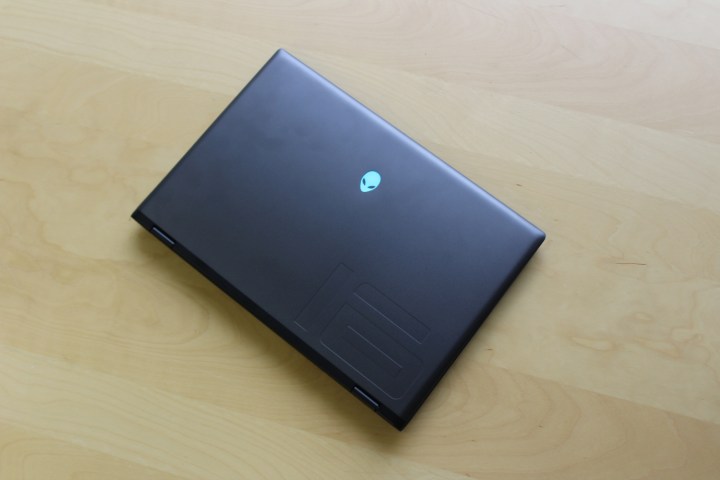
The Alienware m16 R2 is in an awkward spot. On one hand, it’s an attempt by Alienware to modernize its most affordable laptop and compete with the “stealthier” competition. It’s mostly successful in that pursuit, even if it doesn’t go far enough to really challenge Razer or some of ROG’s new releases. But functionally, it’s more compact and the enlarged palm rests are a welcome change.
But the decision to redesign this model into something more conventional does feel a bit strange on its own, especially given how it’s priced compared to the Alienware x16. After all, that laptop was supposed to emphasize a sleek profile and a more modern design — or so I thought.
The Alienware x16 still has a much more premium feel and also offers a wider variety of configurations, with options up to an RTX 4090. And yet, there’s only $50 separating the Alienware x16 R1 from the Alienware m16 R2. Of course, the x16 R2 is coming soon, and we don’t know exactly how that pricing will change. Still, the Alienware m16 feels a bit purposeless in the lineup at this price, unable to drop down much cheaper without eating into the Dell G-series laptop. Part of the problem is that there isn’t a cheaper storage option available, such as a 512GB model. Considering you can upgrade storage yourself, offering a cheaper configuration would have been smart, even with the cheaper RTX 4050 configuration that will eventually come out. All that might sound like a side note, but the way Dell positions these devices internally leads to the decisions that end up in the final product.
Overall, the Alienware m16 R2 is a reboot of the design and sets the foundation for where things could go. But we’re not there yet. If you can find the Alienware m16 R2 discounted for a few hundred bucks, it might be a solid pick-up, especially if you’re a fan of Alienware. But at this price, there are some better options out there, many of which include last-gen gaming laptops that perform just as well. It’s not this laptop’s fault that new mobile GPUs haven’t launched in 2024, but the performance parity with last year’s gaming laptops means newer devices really need to make a statement with its design, display, or price. The Alienware m16 R2 just barely misses the mark in walking that balance.
Editors’ Recommendations
